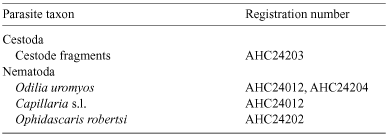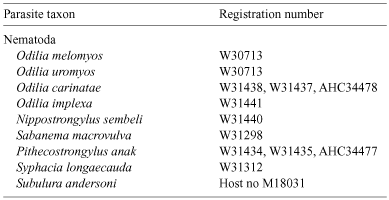Helminth assemblages of Uromys spp. (Muridae : Hydromyinae) from Australia, Papua New Guinea and Papua Indonesia and comparison with assemblages in Melomys spp.
L. R. Smales A B and D. M. Spratt C DA Faculty of Sciences, Engineering and Health, Central Queensland University, Rockhampton, Qld 4702, Australia.
B Parasitology Section, South Australian Museum, North Terrace, Adelaide, SA 5000, Australia.
C CSIRO Sustainable Ecosystems, GPO Box 284, Canberra, ACT 2601, Australia.
D Corresponding author. Email: dave.spratt@csiro.au
Australian Journal of Zoology 56(2) 85-94 https://doi.org/10.1071/ZO08011
Submitted: 30 January 2008 Accepted: 8 July 2008 Published: 9 September 2008
Abstract
This study documents the helminth assemblages of Uromys caudimaculatus (Krefft, 1867) from Papua New Guinea and Australia as well as listing helminths found in U. anak Thomas, 1907 from Papua Indonesia and Papua New Guinea, and U. hadrourus (Winter, 1984) from Queensland Australia. In total, 36 species of helminth, comprising one acanthocephalan, three cestodes (excluding unidentifiable fragments) and 32 nematodes (including two not identified to genus) from 65 hosts were found. The Trichostrongylina nematodes were the dominant group of helminths, the most prevalent species being Odilia uromyos (Mawson, 1961), found in each of the species of Uromys across all regions, and O. melomyos (Mawson, 1961), occurring in U. caudimaculatus from Papua New Guinea and Australia. The helminth species assemblage from U. caudimaculatus, 14 species of helminth from 11 hosts from Papua New Guinea and 23 species of helminth from 51 hosts from Australia, had high species richness but was relatively equitable overall (1/SI = 0.92). The differences found between the helminth assemblages of U. caudimaculatus from Papua New Guinea and Australia suggest that U. caudimaculatus may have travelled to Australia from New Guinea with a small pool of helminth species that was subsequently added to by host switching from sympatric rodent hosts. Alternatively, U. caudimaculatus may have lost many of the helminths that travelled with it following arrival in Australia.
Acknowledgements
Our thanks go to Peter Haycock, Les Moore and Ian Mason for collection of rats in Australia, to Carla Kisinami and Tim Flannery for access to host bodies from the Bishop Museum and the Australian Museum and to Ian Beveridge for assistance with the identification of the cestodes. We are grateful to two anonymous referees whose comments and suggestions contributed significantly to the final form of the manuscript.
Beveridge, I. (1985). The genus Bertiella (Cestoda: Anoplocephalidae) from Australasian mammals: new species, new records and redescriptions. Systematic Parasitology 7, 241–249.
| Crossref | GoogleScholarGoogle Scholar |
Groves, C. P. , and Flannery, T. F. (1994). A revision of the genus Uromys Peters, 1867 (Muridae: Mammalia) with descriptions of two new species. Records of the Australian Museum 46, 145–169.
Ow Yang, C. K. , Durette-Desset, M.-C. , and Ohbayashi, M. (1983). Sur les nématodes parasites de rongeurs de Malaisie. II. Les Trichostrongyloidea. Annales de Parasitologie Humaine et Comparée 58, 467–492.
| CAS |

|

|



